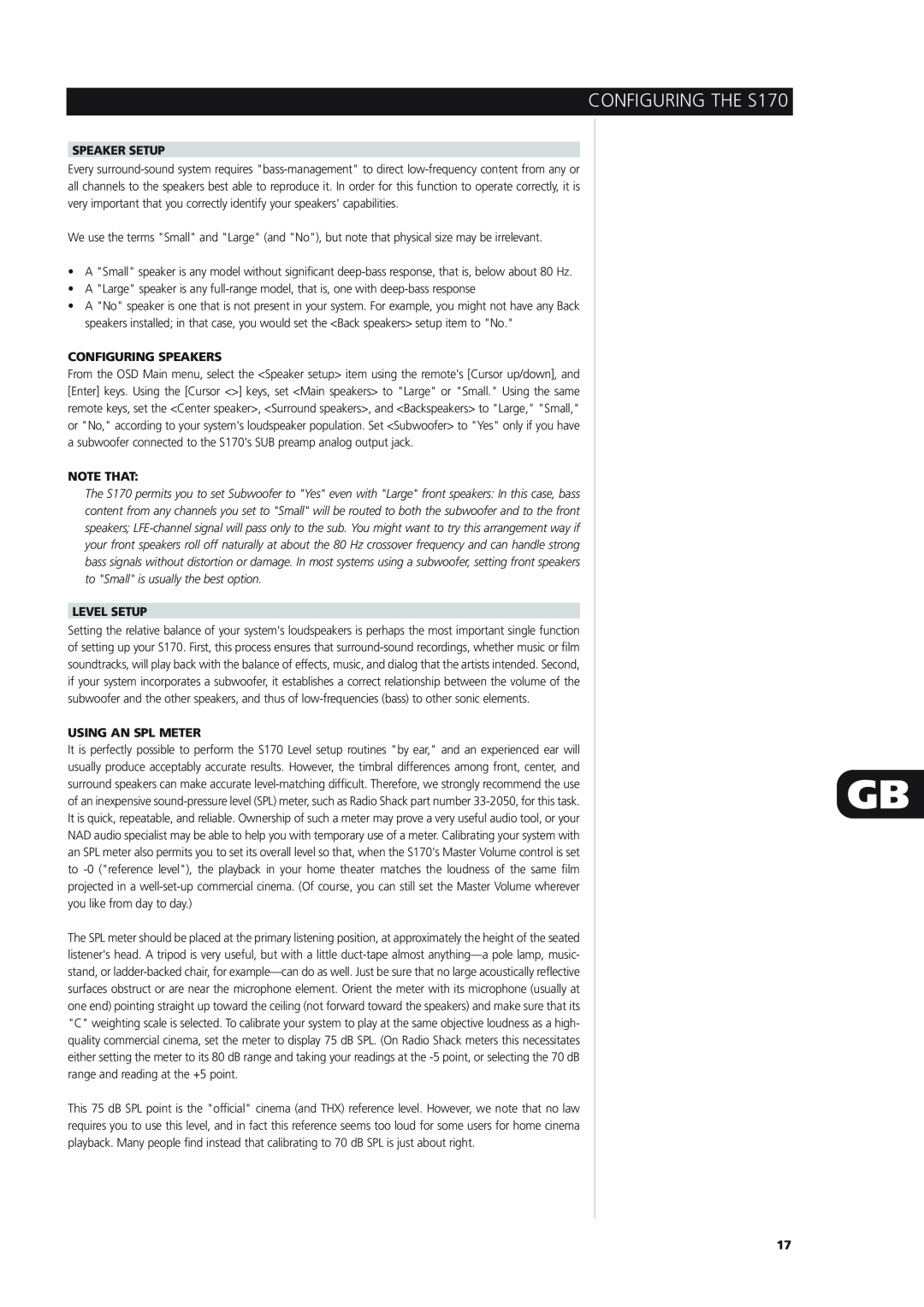SPEAKER SETUP
Every surround-sound system requires "bass-management" to direct low-frequency content from any or all channels to the speakers best able to reproduce it. In order for this function to operate correctly, it is very important that you correctly identify your speakers' capabilities.
We use the terms "Small" and "Large" (and "No"), but note that physical size may be irrelevant.
•A "Small" speaker is any model without significant deep-bass response, that is, below about 80 Hz.
•A "Large" speaker is any full-range model, that is, one with deep-bass response
•A "No" speaker is one that is not present in your system. For example, you might not have any Back speakers installed; in that case, you would set the <Back speakers> setup item to "No."
CONFIGURING SPEAKERS
From the OSD Main menu, select the <Speaker setup> item using the remote's [Cursor up/down], and [Enter] keys. Using the [Cursor <>] keys, set <Main speakers> to "Large" or "Small." Using the same remote keys, set the <Center speaker>, <Surround speakers>, and <Backspeakers> to "Large," "Small," or "No," according to your system's loudspeaker population. Set <Subwoofer> to "Yes" only if you have a subwoofer connected to the S170's SUB preamp analog output jack.
NOTE THAT:
The S170 permits you to set Subwoofer to "Yes" even with "Large" front speakers: In this case, bass content from any channels you set to "Small" will be routed to both the subwoofer and to the front speakers; LFE-channel signal will pass only to the sub. You might want to try this arrangement way if your front speakers roll off naturally at about the 80 Hz crossover frequency and can handle strong bass signals without distortion or damage. In most systems using a subwoofer, setting front speakers to "Small" is usually the best option.
LEVEL SETUP
Setting the relative balance of your system's loudspeakers is perhaps the most important single function of setting up your S170. First, this process ensures that surround-sound recordings, whether music or film soundtracks, will play back with the balance of effects, music, and dialog that the artists intended. Second, if your system incorporates a subwoofer, it establishes a correct relationship between the volume of the subwoofer and the other speakers, and thus of low-frequencies (bass) to other sonic elements.
USING AN SPL METER
It is perfectly possible to perform the S170 Level setup routines "by ear," and an experienced ear will usually produce acceptably accurate results. However, the timbral differences among front, center, and surround speakers can make accurate level-matching difficult. Therefore, we strongly recommend the use of an inexpensive sound-pressure level (SPL) meter, such as Radio Shack part number 33-2050, for this task. It is quick, repeatable, and reliable. Ownership of such a meter may prove a very useful audio tool, or your NAD audio specialist may be able to help you with temporary use of a meter. Calibrating your system with an SPL meter also permits you to set its overall level so that, when the S170's Master Volume control is set to -0 ("reference level"), the playback in your home theater matches the loudness of the same film projected in a well-set-up commercial cinema. (Of course, you can still set the Master Volume wherever you like from day to day.)
The SPL meter should be placed at the primary listening position, at approximately the height of the seated listener's head. A tripod is very useful, but with a little duct-tape almost anything—a pole lamp, music- stand, or ladder-backed chair, for example—can do as well. Just be sure that no large acoustically reflective surfaces obstruct or are near the microphone element. Orient the meter with its microphone (usually at one end) pointing straight up toward the ceiling (not forward toward the speakers) and make sure that its "C" weighting scale is selected. To calibrate your system to play at the same objective loudness as a high- quality commercial cinema, set the meter to display 75 dB SPL. (On Radio Shack meters this necessitates either setting the meter to its 80 dB range and taking your readings at the -5 point, or selecting the 70 dB range and reading at the +5 point.
This 75 dB SPL point is the "official" cinema (and THX) reference level. However, we note that no law requires you to use this level, and in fact this reference seems too loud for some users for home cinema playback. Many people find instead that calibrating to 70 dB SPL is just about right.

